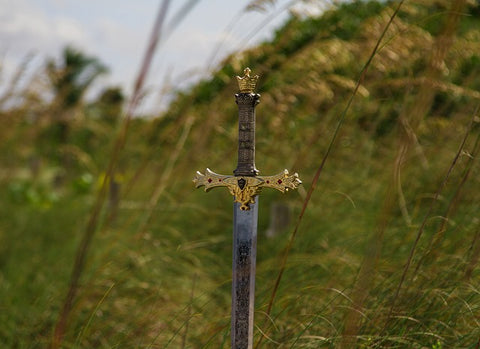Johnny looked down and pursed his lips as he mulled over everything he had just seen. Then he looked up as a thought came to him. “You did a great job explaining the types of swords, and even the progression of materials in the earliest blades. But I notice that while most of the swords here are made from steel, you barely mentioned the progression of materials from iron to steel.”
The shopkeeper brightened. “That’s because the use of steel in a sword was a complex, though interesting historical development.” He went over to two swords that were arrayed vertically, with one above the other. Both had distinctive banding patterns on them.
“The first steel swords would have been made about the same time as the first iron swords, because improperly making an iron sword can actually result in a steel one, albeit of very poor quality. Heating iron with charcoal will introduce carbon into the iron, which is the second ingredient needed to form the steel alloy. However, the key to making steel swords consistently and of high quality requires one to control the carbon content, making sure it is homogeneously spread throughout the entire sword, and to control the tempering and quenching of the steel to a fine degree. Thus, the first consistent production of high-quality steel was in India around 600BC where later they invented crucible steels, such as Wootz”
“Crucible steels were ingenious in their own way. See, coal or charcoal fires have two problems - they are usually not hot enough to completely melt the iron, resulting in an uneven carbon distribution and they introduce too much carbon, forming a substance known as pig iron. Pig iron is too hard and brittle to be used in a sword, but, and - this is key - it has a lower melting point that can be reached by ancient methods. The Indians discovered that by soaking wrought (low-carbon) iron in molten pig iron, the carbon would slowly diffuse from the pig iron into the wrought iron, and thus the carbon content could be controlled (though it was still an imperfect process).”

“Wootz steel was exported to all of the known world, and, later, the Arabs brought the process to Damascus, resulting in Damascus steel that was made using a process not fully rediscovered today. Damascus steel is famed for its unique banding pattern, and modern research has revealed the presence of carbon nanotubes in the metallic structure. Unfortunately, as the process is still lost, only swords that replicate the look can be created today.”
The next sword the shopkeeper came to was curved, and had only one cutting edge. “In Europe, iron typically came from homogeneous ore that could be cut in blocks from which one or more swords could be made. However, in Japan they had iron sands, which meant that the iron needed to be homogenized before it could be made into steel. Now, heating up iron ore will naturally remove many of the impurities, but the problem is that the furnaces of the time had a hard time heating the whole quantity of ore to the needed temperature. Fortunately, many of the impurities in iron have a lower melting point and will flow out of the half-molten iron, but not all of them. However, even with many of the impurities removed the steel was still not high enough quality to make a sword. So the Japanese came up with an ingenious way of homogenizing the steel."
"The process they used was called 'folding', and this worked by hammering the steel flat, folding it, and forge welding it to itself. This had the advantage of evening out any impurities in the blade and, in addition, could also remove a bit more of them by forcing out the molten impurities using the pressure of the hammer stroke. The disadvantage of folding is that it reduces the amount of carbon in the steel, turning it back into iron if done for too long. Thus a balance must be struck between removing impurities without losing too much carbon.”
“Japanese swords have a unique aesthetic look, combining the layered look of the folded metal with the swords' distinctly curved blades and single-edges. The reason for this is that, unlike many European swords which focused on thrusting, Japaneses swords were designed primarily for cutting. The curve was because two different types of steel were combined - one hard and brittle that could hold the sharp edge needed for cutting, and the other tough and flexible that could bend without breaking. This forging method, however, takes much more labor and skill, increasing the costs of the blades.”
“Today, we have the best of both worlds. We can import iron ore from anywhere in the world and completely melt it, allowing us to have homogeneous steel with a chosen carbon content. However, the ancient sword forging methods are not lost, and all the swords here have been hand-produced using traditional methods dating back hundreds of years. We just have the advantage of using modern sources for the steel - ensuring consistently high quality blades at much more affordable prices.”
“So”, concluded the shopkeeper, “do you have any more questions?”. John looked up, smiled, and said, “No, you’ve been most informative”. “I see some Clay Tempered Steel Swords. Can I take a closer look at them?” "Of course", replied the shopkeeper enthusiastically. “Follow me”.
**
Learn more:
source https://www.bladespro.co.uk/blogs/news/the-soul-of-a-sword-from-iron-to-steel











